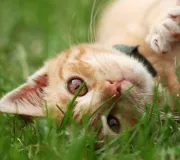Have you ever come home and found that your canine pal has eaten your shoes, or chewed up your sofa? This may go beyond Fido’s natural need to chew. There’s actually a specific name for this behavior: pica. The whats, whens, and whys of pica in dogs can vary widely. A local vet offers some information on it below.
Grass
One of the most common forms of pica is eating grass. There are several possible reasons for this. Fido may be trying to soothe an upset stomach, or he may be trying to address a nutritional imbalance, which may have manifested as a craving. While most grass isn’t dangerous in and of itself, many plants are. Plus, a lawn that has been treated with chemicals or pesticides is definitely not safe for your pooch to eat. Your furry pal could also pick up parasites.
Fido Ate What?
It isn’t usually going to be an emergency If Fido snacks on your lawn. Unfortunately, though, pica isn’t limited to grass. Our canine friends have been known to eat all sorts of things. Socks and underwear are two common items. Man’s Best Friend has also eaten rocks, nails, screws, toys, watches, batteries, and, of course, homework, to name just a few things. As one can imagine, these things are definitely not safe for your furry friend. Some can cause choking or intestinal damage or blockages. Others, such as batteries, are highly toxic. In some cases, dogs’ ‘snacks’ will pass out the usual way. However, some cases can become life-threatening, and require surgical intervention. Call your vet immediately if you know or suspect your dog has eaten something he shouldn’t have.
While dogs may engage in pica for various reasons, cats are known for their love of sleeping. If you’re curious about your feline friend’s sleeping habits, check out our article ‘Why Do Cats Like to Sleep So Much?‘ to learn more about the factors that influence their daily snooze time.
Treatment
The first course of action in pups with pica is having Fido examined by a vet. It’s important to determine if your pooch has nutritional issues or health problems. Thyroid issues, diabetes, and malnutrition are a few possibilities. Your vet may recommend changing Fido’s diet, or putting him on medication and/or supplements.
It’s also important to realize that sometimes dogs engage in pica due to mental or emotional issues, such as stress, fear, or loneliness. Make sure Fido has suitable toys and playtime, and spend lots of quality time with him. Puppyproofing is also a must. Ask your vet for more information.
Our Advice on Pica In Dogs in 2024
What is pica?
Pica in dogs is a behavioral condition characterized by the ingestion of non-food items. This can include a variety of objects such as rocks, socks, nails, and even batteries. The reasons behind pica can vary, ranging from nutritional deficiencies and underlying health issues to emotional or mental distress like boredom, stress, or anxiety. It’s crucial to address pica promptly, as consuming inappropriate items can lead to serious health risks, including choking, intestinal blockage, or toxicity. Veterinary evaluation is essential to diagnose and treat the root causes of pica.
Why do dogs sometimes eat grass?
Dogs may eat grass for several reasons, including to soothe an upset stomach or address a nutritional imbalance, possibly manifesting as a craving. Eating grass is one of the most common forms of pica, a condition where dogs consume non-food items. While grass itself isn’t typically harmful, concerns arise if the grass has been treated with chemicals or pesticides, or if it leads to the ingestion of parasites. In many cases, grass-eating is a normal behavior, but it should be monitored to ensure it doesn’t indicate underlying health issues.
What signs might indicate your dog has eaten something they shouldn’t?
Signs that your dog has ingested something harmful may include vomiting, diarrhea, decreased appetite, lethargy, abdominal pain, and changes in bowel movements or difficulty defecating. You may also notice your dog coughing, gagging, or showing signs of distress. In some cases, there could be visible evidence of the non-food item in their stool or vomit. If you observe any of these symptoms or suspect your dog has eaten something they shouldn’t, it’s crucial to contact your veterinarian immediately, as some situations can become life-threatening without prompt treatment.
How can you prevent your dog from engaging in pica?
Preventing pica in dogs involves addressing both the physical and emotional needs of your pet. Ensure a balanced diet to eliminate nutritional deficiencies and have regular veterinary check-ups to catch any underlying health issues early. Our Vet Nutrition and Weight Management service can help you develop a personalized dietary plan to ensure your dog receives all the necessary nutrients and maintains a healthy weight. Mental stimulation is crucial; provide plenty of toys, engage in regular playtime, and exercise to prevent boredom and stress. Puppy-proof your home by securing trash, removing small objects that can be swallowed, and restricting access to harmful substances. Understanding and meeting your dog’s dietary, health, and emotional needs are key steps in preventing pica behavior.
Are there certain breeds or ages of dog that are more prone to pica?
Yes, certain breeds and ages of dogs may be more prone to pica. Younger dogs and puppies, due to their natural curiosity and tendency to explore the world through their mouths, may exhibit pica more frequently. Among breeds, those known for their high energy levels and intelligence, such as Labrador Retrievers and Border Collies, might be more predisposed to pica if not provided with adequate mental stimulation and physical exercise. However, pica can occur in any breed and at any age, emphasizing the importance of environmental management and appropriate care to prevent this behavior.
Do you have questions about your dog’s health or care? Contact us, your animal clinic in St. Lucie County, FL, today.

